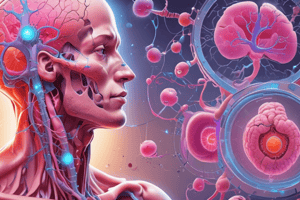Podcast
Questions and Answers
What is the primary purpose of homeostasis in organisms?
What is the primary purpose of homeostasis in organisms?
- To keep internal conditions near constant (correct)
- To allow rapid adaptations to the environment
- To maximize energy production
- To enhance growth and reproduction
Regarding tissue fluid, what effect does a high temperature have on cellular activities?
Regarding tissue fluid, what effect does a high temperature have on cellular activities?
- Speeds up enzyme activities
- Promotes cell division
- Enhances metabolism
- Denatures proteins (correct)
Which physiological factor is NOT controlled by homeostasis?
Which physiological factor is NOT controlled by homeostasis?
- Blood pH
- Blood glucose concentration
- Heart rate variability (correct)
- Core body temperature
What initiates the negative feedback mechanism in homeostasis?
What initiates the negative feedback mechanism in homeostasis?
In the context of homeostasis, how does the nervous system transmit information?
In the context of homeostasis, how does the nervous system transmit information?
Which of the following statements about glucose concentration in tissue fluid is correct?
Which of the following statements about glucose concentration in tissue fluid is correct?
What role do effectors play in the homeostatic control mechanism?
What role do effectors play in the homeostatic control mechanism?
What is the primary component of the negative feedback system in homeostasis?
What is the primary component of the negative feedback system in homeostasis?
Flashcards
Homeostasis
Homeostasis
Maintaining a stable internal environment in an organism despite external changes
Tissue fluid
Tissue fluid
The fluid surrounding cells, providing their immediate environment.
Negative feedback
Negative feedback
A control mechanism where a change triggers a response to counteract the change and return to a set point.
Set point
Set point
Signup and view all the flashcards
Receptor (sensor)
Receptor (sensor)
Signup and view all the flashcards
Effector
Effector
Signup and view all the flashcards
Internal environment
Internal environment
Signup and view all the flashcards
Physiological factors controlled
Physiological factors controlled
Signup and view all the flashcards
Study Notes
Homeostasis
- Organisms maintain stable internal conditions (homeostasis)
- Sensory cells detect internal and external conditions
- Controlled factors include: body temperature, metabolic wastes (urea, CO2), blood pH, blood glucose, and blood oxygen and carbon dioxide levels
Internal Environment
-
The internal environment surrounding cells is tissue fluid
-
Tissue fluid's key characteristics affecting cell function:
- Temperature: Too low slows activity; too high denatures proteins (enzymes).
- Water potential: Decreasing water potential forces water out of the cell, slowing/stopping metabolism; increasing water potential causes swelling/bursting.
- Glucose concentration: Too low slows/stops respiration; too high causes water to leave cells, disrupting metabolism.
- pH: Affects enzyme activity; optimal range for cytoplasm is 6.5-7.0.
-
Homeostasis primarily controls the composition of blood and tissue fluid.
Homeostatic Control
- Most homeostatic mechanisms use negative feedback
- Mechanisms involve a receptor (sensor) and an effector (muscle or gland).
- A receptor detects a stimulus (change in a physiological factor).
- Information (input) is relayed to a control center (brain or spinal cord).
- The control center directs the effector (e.g., a gland or muscle) to take corrective action (output).
- This corrective action reverses the change and maintains the factor around a set point (ideal value).
- Negative feedback: An increase in a factor triggers a response to decrease it, and vice-versa.
- Homeostatic mechanisms rely on communication between the nervous and endocrine systems.
- Nervous system uses electrical impulses; endocrine system uses hormones.
Studying That Suits You
Use AI to generate personalized quizzes and flashcards to suit your learning preferences.
Description
Explore the concepts of homeostasis and how organisms maintain stable internal conditions. This quiz covers sensory detection, factors affecting the internal environment, and the significance of tissue fluid. Test your understanding of how metabolism is influenced by temperature, water potential, glucose concentration, and pH levels.



